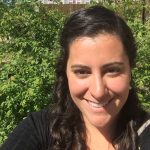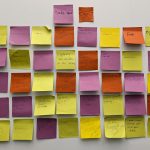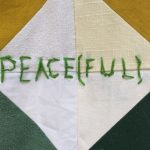Harold Washington Library Center's Fall Maker-in-Residence, Daliah Silver, reveals the inspiration, creativity and sustainable processes involved in creating the Chicago Public Library Community Quilt. The CPL Community Quilt is on display now along State Street at Harold Washington Library Center until June 30, 2024.
As the Maker-in-Residence with Chicago Public Library, I taught 9 classes on the power of words and storytelling, finding inspiration, and making space for your own voice, all through the medium of quilts. During each class I asked patrons to answer the following questions: “What does the Library mean to you? Why do you keep returning to the Library? What values does the Library hold in your life?” Each patron wrote down a word or phrase that best answered this question, which I collected at the end of each class. Over the course of the past few weeks, I have been slowly embroidering those words into a large community quilt.
Community Quilts have a long history in the world of textiles. Throughout history, people, especially women, would come together, leaning over communal cloth, stitching thread through layers of fabric and batting, sharing stories, knowledge, and memories. More organised quilting bees include the Hoosier Suffragette Quilt, the AIDS Memorial Quilt, and the Freedom Quilting Bee in Gee’s Bend, Alabama.
Inspired by the colours of the 150th anniversary of the Chicago Public Library, to prepare the quilt, I delved into my fabric stash, gathering scraps of yellows, whites, creams, and greens. The center of the quilt showcases a variety of fabric: golden yellow from one of the first quilts I made for a sick and grieving friend, dark green from a quilt for my nephew, sage green from a “maker box” - cast off scraps of a local clothing company, who send off their unused fabric so folks can repurpose textiles into art, and a bright yellow for a quilt I am currently working on to sit under in the cold Winter nights. The rest of the fabric was acquired from The WasteShed, a nonprofit creative reuse center in Chicago and Evanston, providing second hand, gently used art supplies.
Sustainability and low waste is an essential part of my practice. Americans throw out 17 million tons of textile waste each year, and the average garment is worn 7 times before it is tossed away. While we assume and hope makers are cognisant of their fabric consumption and waste as they work, there are always bits we don’t use. We buy new fabric, then decide it no longer suits our needs. We buy more than we need and have yards left over. We throw scraps out, even scraps that could have been used for other, smaller, projects. My goal is to always search first through my stash, then secondhand art stores, and finally thrift stores, to see if there is old clothing I can rip up and sew up into something new.
The Chicago Public Library Community Quilt is composed of a hodge podge of various fabrics, some natural, such as cotton and linen, and some synthetic (you can see a small burn mark in one corner of the quilt where I forgot to switch my iron setting. Synthetic fabric, as it is made of plastic, is more susceptible to burning, as opposed to linen or cotton, which can be ironed on a higher setting). The Star Block, a common quilt block design, often referred to as the Carpenter Star Block, is one of my favorites to create, allowing me to play with colour and placement to create an ever changing design within the same motif. I sewed the stars together, then collected all the words patrons provided and stitched them in the “blank spaces” between the stars. Many words repeated on a variation, so I combined them into one block, to showcase the collective experience of the CPL patrons. Hand stitching each word was an honor, to pause and make space for every person who passes through the doors of the Library, who find what they need between the stacks of books.
Once the top was assembled, I lay the back (pieced together of all the leftover, unused fabric) on the floor, lay the batting on top, and began to pin baste the top, sandwiching the three pieces together. I hand stitched the layers with quilters cotton thread, also from The WasteShed. My preference is always to hand stitch my quilts, as it allows me more time with the quilts, meticulously leaning over every inch of the quilt, and provides me the chance to lay under the quilt one last time. The binding and loops were added at the end, closing out the project and my role as the Fall Maker-in-Residence with the Chicago Public Library.
Learn more about Maker Lab equipment or check out our upcoming classes.
The Maker-in-Residence is generously funded by the Chicago Public Library Foundation.








Add a comment to: Guest Blog: Creating a Community Quilt by Daliah Silver, Maker-in-Residence